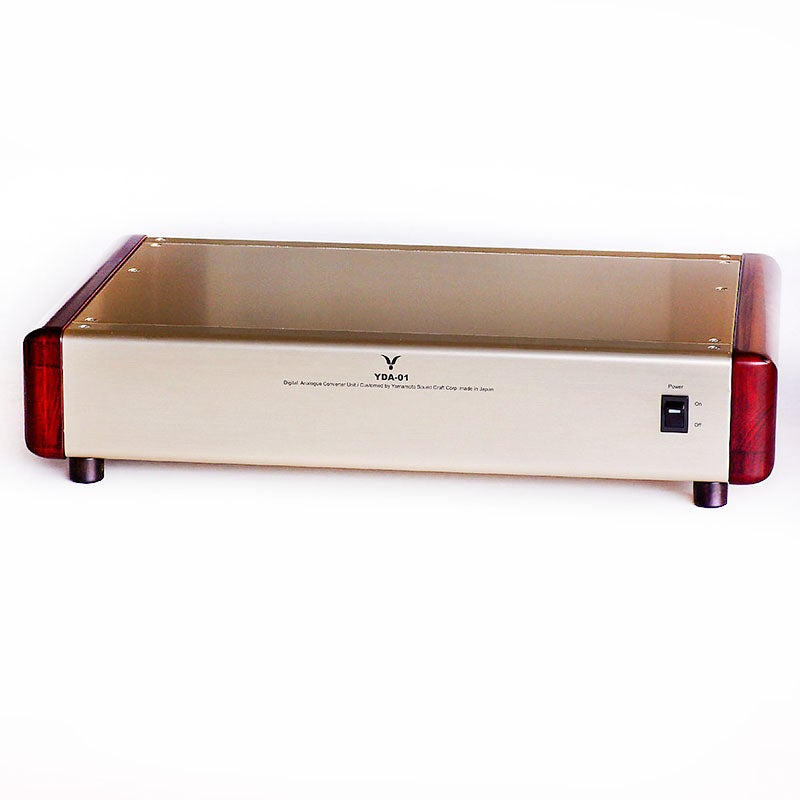It becomes an order-made product. Delivery time is about 4 months.
Extract accurate reproducibility
To solve the hardness of CD player sound
Description

Simple circuit and careful power circuit, DAC device is LR independent configuration

The output side of the DA converter IC is current output. The DA converter IC and PCM1794A used for this machine are also the current output of the operating circuit. With the conclusion that the simplicity of the circuit and the small number of elements passing through the sound quality is superior, the circuit adopted was a base ground by one transistor and an output circuit with no feedback single method. It is a very simple configuration that converts the current output to a voltage with only one transistor and one resistor, as is the output circuit. With this circuit, the sound quality became very natural and the sound was fresh and full of dynamic feeling.
DA Converter IC uses 2 PCM1794A in mono mode for maximum performance
The DA Converter IC uses a high-performance PCM1794A in mono mode with one L/R channel each to provide a powerful, energetic sound with a para connection without interference between channels.

Supplied from a separate regulator circuit eliminates power interference with the circuit
The power transformer employs a large-capacity toroidal transformer, which separates the analog and digital winding and reduces interference between the two. The transformer is a careful power supply circuit that separates the digital part, the analog part, and the output circuit from the separate regulator. Teflon insulation and silver-plated copper wire are used for wiring materials with extremely high reliability and excellent sound quality.

Spec
| Digital Input Terminal | Coaxial 1 system (RCA) |
|---|---|
| Analog Output Terminal | Coaxial 1 system (RCA) |
| Output Level | 3.1V/0dB |
| Corresponding frequency | 32-192kHz (auto-follow) |
| Sampling Filter | 8X Oversampling Digital Filter |
| Frequency Characteristics | 20~20kHz(±1dB) |
| SNR | 86dB (IHF-A waght) |
| Output Impedance | 2.6kΩ |
| Size | 420(W)290(D)94(H)mm/5.2kg |
Review
A simple circuit configuration of one transistor, a thorough design that operates in mono mode of one L/R1, a large toroidal transformer installed on the power supply, a winding line divided into digital/analog/output, and a careful power circuit that supplies the IC power supply from a separate regulator.In this way, the YDA-01 with simplification and power enhancement as a point has a refreshing and stretching tone, and the rich sound is clear. The range is wide enough and the energy is uniform and smooth response in any band. The texture and aftertaste of Boy Soprano's voice are delicately drawn, and the point is probably a sound quality feature. However, it is not only delicate but also has powerful power, and in jazz it sounds utto bass and drums with a constant response. However, even in such a case, it is never rough, and it seems to be the essence of the machine that drifts quiet atmosphere based on fine resolution power. So it is natural that the nuances of the guitar stand out and listen to it in detail. The tone of the strings is neutral and does not exaggerate, and it captures the change of the quiet but subtle timbre. And there are lingering lingerie. It is likely that the character is seen from the appearance of this afterglow, although the sound does not faint. In the orchestra, the sound of the strings is soft and moist, and I feel the calmness of the grains. And because of the source, it demonstrates the beauty and vivid color feeling without regret. Or even the piano of the Fazil Rhinoceros, it corresponds gently to the fast-moving touch, each sound is very clear. It is clear that the real feeling of the sound image and the spatiality on the stage enhance the real touch. Accurate reproducibility is evident in the beauty of the chorus and the thickness of the sound, the presence of focus tightened without blurring while rich in flesh texture. It attracts people who listen to the music itself.
*STEREO SOUND




































